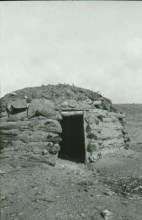Article
It is not uncommon for the Navajo to have a summer and winter dwelling. A hogan is a traditional Navajo home. Hogans are generally round (female) or, less commonly, cone shaped (male), with the door facing east. The earliest hogans were called forked-stick hogans and were made from wooden poles forked together at the top to form a conical structure that was then covered with mud; the construction is very specific and the directions for building a hogan have been passed down for generations, originating with the Holy People.
A winter hogan is generally located at lower elevation pasture land. This structure is made of wooden planks and can be covered in earth for better insulation. However, winter hogans can also be used during summertime.
"Navajo winter hogan, New Mexico, 1926," photograph, Hartley Burr Alexander Collection (LS.2205). Palace of the Governors Photo Archive, New Mexico History Museum, Santa Fe. All rights reserved. Use with permission only.
Manuscripts
References
Jett, Stephen C., and Virginia E. Spencer
1981 Navajo Architecture: Forms, History, Distributions. Tucson: University of Arizona
Press.

